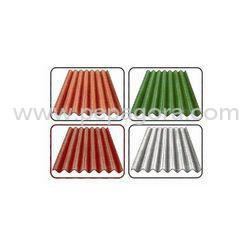Maspack Ltd
Product Range
Fact Sheet
- Location:Andhra Pradesh, India
- Year of Establishment:1991
- Business Type:Manufacturer, Trading Company, Exporter
- Main Products:Pulp Moulding Plants, Pulp Moulded Packaging
- Reviews & Rating:
Get Verified, Sell more with
- Buyer's trust
- Faster conversions
- Better Rankings
- More
Its Free
Verify NowCorrugated Asphaltic Sheet Roofing Plant
The building industry in India has been rapidly developed over the years and there is sustained acceleration in building activities.
- FOB PriceNA
- Min Order QuantityNA
- Payment TermsNA
Other Details
Corrugated Asphaltic Sheet Roofing Plant
The building industry in India has been rapidly developed over the years and there is sustained acceleration in building activities.
Therefore there is a huge demand for the roofing sheet, which is the key module in all types of buildings. The technology offers tremendous market potential. We offer the most modern technology capable of completely replacing traditional asbestos roofing sheets in every aspect of efficiency, economy and environment friendly benefits.
Strength of the Product
The introduction of Asphaltic Roofing Sheets from Maspack greatly enhances the efficiency of the roofing in many ways. Unlike the presently available light roofing sheets in the market where the corrugation gets flattened due to its artificial make, Maspack's roofing sheets retains the shape and resistance for years to come due to its state-of-the-art Vacuum Moulding Technology.
Latest Technology Process
The Maspack Corrugated Asphaltic Roofing Sheet production process starts with the conversion of the waste paper into pulp using a highly advanced Hydropulper. The pulp made to the required consistency is then run through a vibrating screen with traps. This combination removes all unwanted materials from the pulp, which then flows into the pulp tank. The cleaned and ready pulp is pumped to an overhead pulp chest using a wide mould special pulp pump.
A multi disciplined state-of-the-art moulding machine then transforms the 1% consistency pulp that flows into its forming mould pattern into the correct product profile. This is achieved by the vacuum suction of the water from the pulp. When the water is removed by vacuum, it leaves a fibre mat on to the mould surface, which automatically takes the shape of the product. The wet profile of the product is transferred from the surface of the forming mould.
The wet product with a carrier facility of identical shape is lead to a press, which removes the excess water to give stability to the product. After pressing, the wet product is separated from the pellet and is loaded into the multi rack trolley. The trolley is then pushed to the drier or drying yard for sun drying. The corrugated sheets after drying is loaded on to an impregnating cradle, moved by a traveling electric hoist.
The cradle then moves and gets lowered/immersed into the 2000C hot melt asphalt. The correct ratio of paper to asphaltic impregnation is achieved by the heat level control on the asphalt as well as the time set for the impregnation. The product then moves through a coolant area and is transferred into a conveyor that moves through a painting bay for getting the required colour coat. The roofing sheet then is counted, made into bundles and moves for dispatch to the depot.
Images




